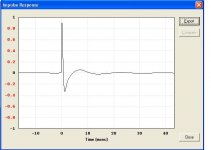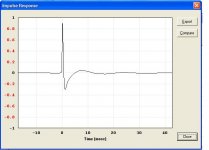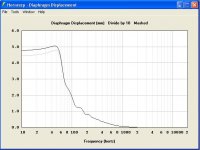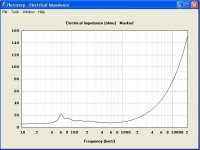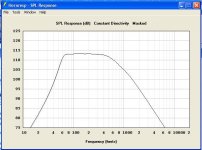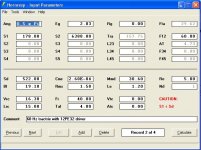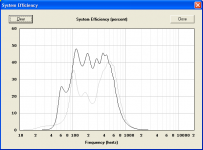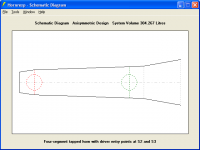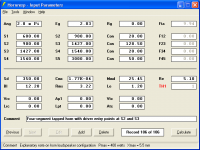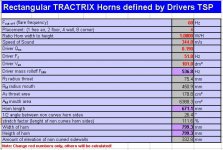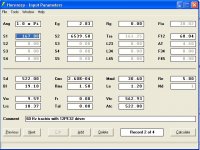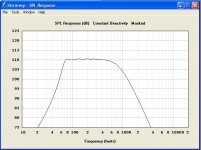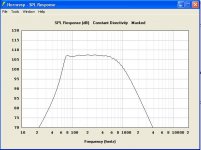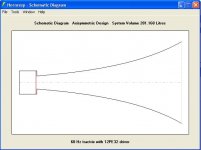The impedance peak is a function of the driver in the rear enclosure coupled to the horn.
When you have the same acoustical impedance on the front and the back of the cone you have an ideally loaded horn. That is the general goal of reactance annulling.
You have described the variables quite well.
It's all about compromise.
If you want to tailor the roll off below the Fc of the horn you can increase the size of the rear enclosure. But there are penalties to be paid in such an endeavor. Loss of efficiency and proper control of the drivers behavior.
There is much more to be described. And there are a few gentlemen on this thread that are very capable of fleshing this out, or correcting anything that I may have erred on.
When you have the same acoustical impedance on the front and the back of the cone you have an ideally loaded horn. That is the general goal of reactance annulling.
You have described the variables quite well.
It's all about compromise.
If you want to tailor the roll off below the Fc of the horn you can increase the size of the rear enclosure. But there are penalties to be paid in such an endeavor. Loss of efficiency and proper control of the drivers behavior.
There is much more to be described. And there are a few gentlemen on this thread that are very capable of fleshing this out, or correcting anything that I may have erred on.
Last edited:
When you have the same acoustical impedance on the front and the back of the cone you have an ideally loaded horn. That is the general goal of reactance annulling.
When I use the exact calculated values, I get the -3dB point at the horn cut off and excursion is controlled. A small resonance peak remains in the electrical impedance curve however. If Hornresp is an accurate representation of reality, then the Keele and Leach equations are accurate as well. Attached are the results using 2 different equations to determine the Vrc. It does appear to be a compromise and measuring the electrical impedance such that the curve does not have any peak in order to determine the best value for Vrc seems to be a mistake.
Attachments
Remember that all these "exact" formulas are best worked out mathematical representations of what happens in the real world. The real world is where "exact" lives. And "exact" has an evil sense of humor. I think he is related to Mr. Murphy of long quoted axiom.When I use the exact calculated values, I get the -3dB point at the horn cut off and excursion is controlled.
What I can tell you is that I have been using Hornresp since 2002 and it is one of the best most versatile acoustical simulation programs that I have ever fooled around with. And it can be extremely accurate. The caveat being that you build exactly what you have simulated. I have posted many examples of measurements agreeing with simulations.
Your questions are leading towards what kind of a horn? Theoretical or real?
When you build the horn you can then make changes on the rear chamber and measure their resulting changes.
Keep in mind to that you are simulating a perfect circular horn. If you make anything other than that, in the mid to high frequency range you will be making further compromises. That to will change the way in which the acoustical impedance varies with frequency in the throat and how a rear chamber will help you to mitigate most of these variances. Reactance annulling really occurs over a relatively narrow band of frequencies close to the Fc of the horn.
It is all a matter of balance. Compromise in one area for another.
Hard and set formulas and exact calculations are mere figments of our imaginations..
We are simulating best guesses and their hoped for results.
What you build is the final arbiter. And how it sounds is what really matters.
If you want a given Tractrix horn the first thing you may want to figure is building it to accomplish the required low end . They roll off rather quickly in real life. A variant by Jean Michel LeCleach is better suited to what you seem to be after.
Your questions are leading towards what kind of a horn? Theoretical or real?
If you want a given Tractrix horn the first thing you may want to figure is building it to accomplish the required low end . They roll off rather quickly in real life. A variant by Jean Michel LeCleach is better suited to what you seem to be after.
I designed a 1/4 size 60Hz tractrix horn for the B&C 12PE32 driver using a spreadsheet and simulated it in 1/8 space in Hornresp. I've attached the input screen for Hornresp. I've already purchased the drivers. I just want to finalize the design and answer some questions. I found that the horn simulated much better in 1/8 space than in 1/4 space. In 1/8 space it actually goes down to the designed cut off of 60Hz. Tractrix bass horns are known for not extending down to the cut off frequency. The shape of the horn is going to be a typical Edgar style with 2 straights sides and 2 curved ones.
Can you provide a source for designing a LeCleach horn? I need a spreadsheet or something.
Thank you very much for your help and insight! Much appreciated!
Attachments
Last edited:
Can you provide a source for designing a LeCleach horn? I need a spreadsheet or something.
It's in Hornresp!
Read the manual.
1/8th space is a very optimistic place to be that does not really exist in normal listening environments where you would be using this type of a horn.
Simulate it in 2 Pi and see what you get.
And if you are close to a wall and have good boundary reinforcement from say a concrete basement you could get away with 1 Pi.
1/8th Pi only really works with a concrete floor walls an ceiling.
As in perfectly reflective surfaces.
I do believe the acoustic impedance should be used to design the horn, and the electrical impedance is best used to design the back chamber.When I use the exact calculated values, I get the -3dB point at the horn cut off and excursion is controlled. A small resonance peak remains in the electrical impedance curve however. If Hornresp is an accurate representation of reality, then the Keele and Leach equations are accurate as well. Attached are the results using 2 different equations to determine the Vrc. It does appear to be a compromise and measuring the electrical impedance such that the curve does not have any peak in order to determine the best value for Vrc seems to be a mistake.
Hornresp Version 28.70
Hi Everyone,
The latest Hornresp release (Product Number 2870-110815) has the following two new features:
1. Four-segment tapped horns can now have the mouth-end driver entry point at either S3 or S4, as requested by Dan. To select the four-segment S3 driver position option, double-click on the red TH label when in edit mode to change to TH1.
2. The Compare function has been extended to the System Efficiency, Sound Pressure and Particle Velocity charts, as suggested by Oliver. Functionality remains the same as for other charts - previous results are used in comparisons by default, but results can also be captured or released by right-clicking the relevant chart and selecting the appropriate popup menu command, or by pressing Ctrl+C to capture the current results or Ctrl+X to release captured results.
Could you please let me know if you find any bugs. Thanks.
Kind regards,
David
Hi Everyone,
The latest Hornresp release (Product Number 2870-110815) has the following two new features:
1. Four-segment tapped horns can now have the mouth-end driver entry point at either S3 or S4, as requested by Dan. To select the four-segment S3 driver position option, double-click on the red TH label when in edit mode to change to TH1.
2. The Compare function has been extended to the System Efficiency, Sound Pressure and Particle Velocity charts, as suggested by Oliver. Functionality remains the same as for other charts - previous results are used in comparisons by default, but results can also be captured or released by right-clicking the relevant chart and selecting the appropriate popup menu command, or by pressing Ctrl+C to capture the current results or Ctrl+X to release captured results.
Could you please let me know if you find any bugs. Thanks.
Kind regards,
David
Attachments
I designed a 1/4 size 60Hz tractrix horn for the B&C 12PE32 driver using a spreadsheet and simulated it in 1/8 space in Hornresp.
Hi dirkwright,
The tractrix horn you are proposing has a severely truncated mouth. In such cases a simple exponential flare having the same S1, S2 and L12 values will normally perform just as well. Tractrix and Le Cléac’h horns are really intended to have fully-formed mouths. Otherwise, there is little to be gained in using them - it is just an unnecessary complication
Kind regards,
David
Hi dirkwright,
The tractrix horn you are proposing has a severely truncated mouth. In such cases a simple exponential flare having the same S1, S2 and L12 values will normally perform just as well. Tractrix and Le Cléac’h horns are really intended to have fully-formed mouths. Otherwise, there is little to be gained in using them - it is just an unnecessary complication.
Kind regards,
David
If that is the case, then the spreadsheet I am using is wrong.
The horn length in your software does not match the length shown by the spreadsheet I'm using.
Attachments
Last edited:
I think your application of the spread sheet is in error.
Remember that a successful horn in a standard application is usually best created using a 1/4 space or 1 Pi size as a minimum. Your horn design using a 1/8th space loading and looking good...
Well that will only exist on your computer screen. That is what David is referring to as a severely truncated mouth. It should be at least twice the current size.
Remember that a successful horn in a standard application is usually best created using a 1/4 space or 1 Pi size as a minimum. Your horn design using a 1/8th space loading and looking good...
Well that will only exist on your computer screen. That is what David is referring to as a severely truncated mouth. It should be at least twice the current size.
I think your application of the spread sheet is in error.
Remember that a successful horn in a standard application is usually best created using a 1/4 space or 1 Pi size as a minimum. Your horn design using a 1/8th space loading and looking good...
Well that will only exist on your computer screen. That is what David is referring to as a severely truncated mouth. It should be at least twice the current size.
In the spreadsheet, I designated 1/4 size for the horn. If it was twice the size, then it'd be a 1/2 size horn, wouldn't it? What exactly is wrong with the spreadsheet? I got it from here:
Download Section
Ok I'm not going to get into vetting a spreadsheet. You have a very powerful program on your computer called Hornresp.
Punch in your numbers in the bottom section where you enter in the driver parameters.
Set your Ang to 1 Pi.
Go to the tools section and click on system design and use the section with driver. This will get you a near perfect horn for what you are looking for. That will get you a horn profile. Click on the Hyp section and press T on your keyboard this will change the horn profile to Tractrix. Now simulate and fool around.
Punch in your numbers in the bottom section where you enter in the driver parameters.
Set your Ang to 1 Pi.
Go to the tools section and click on system design and use the section with driver. This will get you a near perfect horn for what you are looking for. That will get you a horn profile. Click on the Hyp section and press T on your keyboard this will change the horn profile to Tractrix. Now simulate and fool around.
Ok I'm not going to get into vetting a spreadsheet. You have a very powerful program on your computer called Hornresp.
Punch in your numbers in the bottom section where you enter in the driver parameters.
Set your Ang to 1 Pi.
Go to the tools section and click on system design and use the section with driver. This will get you a near perfect horn for what you are looking for. That will get you a horn profile. Click on the Hyp section and press T on your keyboard this will change the horn profile to Tractrix. Now simulate and fool around.
OK, thank you. I did that and the results are not much different for throat and mouth area from the spreadsheet. The SPL in quarter space shows -3dB about 68Hz. If I put it in a corner, the response flattens out and the -3dB goes down a few Hz. How do you get a horn profile from this program?
Attachments
Last edited:
Change the Ang to 2 Pi and you will see the response that you can expect in a normal configuration. If you like that your golden.
Thanks. I did that.
Looks kind of ragged to me. What can I do to make it smoother? Why do we have to jump through so many strange hoops to see a real world result?
Attachments
You have a perfect and I mean perfect response. That tiny bit of ripple will never be audible. And never see the light of day. It willl be worse in real life measurements. But that being said if you measure speaker you think sound pretty good you fall off of your chair when you look at the peaks and dips we hear in our listening rooms.
You have gotten where you wanted to without reading the sign posts buddy.
You have gotten where you wanted to without reading the sign posts buddy.
You have a perfect and I mean perfect response. That tiny bit of ripple will never be audible. And never see the light of day. It willl be worse in real life measurements. But that being said if you measure speaker you think sound pretty good you fall off of your chair when you look at the peaks and dips we hear in our listening rooms.
You have gotten where you wanted to without reading the sign posts buddy.
Thanks. I'm kind of known for not reading the sign posts...
How do I export the horn expansion so I can make this horn in real life?
Why doesn't the schematic show the horn ending in a 90degree flare? I thought tractrix horns were like that?
So this horn is supposed to be 1.6 meters long? dang that's big.
Attachments
Man !
I read through the manual and it is not that easy to send you to the right page and show you how to export the information.
So here goes.
Go to the Schematic page.
Click on file.
Export, horn data.
A box pops up.
If you are going to build a square horn you are good to go as Hornresp computes a square cross section to begin with.
If you want any other size alter the Height boxes S1...........
The Increment window can have larger values and save you on paper. I usually use 10 cm for a horn the size you are making.
25.4mm = 1 inch, 2.54 cm = 1 inch
Hit the ok button.
Name your file.
Go to your Hornresp installation folder and find the export folder.
In that export folder you will find the file you just created.
Open it up in Notepad or what ever word processor you have.
Print it.
Read until it makes sense.
The collums are as follows:
Length is the length from the driver towards the horn mouth
Area is the area of the horn at the specified length in square centimeters.
Radius is the radius of a circle of the same area as above.
Angle is the angle of the horn wall measured off of a flat plane where the driver bolts onto the horn.
Height Your on your own buddy.
Width ""
Width Flare is the type of horn Con Trac Hyp or Uni. Uni is a horn where you set up Hornresp to make a horn having two parallel side walls and the rest changes. In other words you are specifiying the horns width.
Side Length. See ""
I read through the manual and it is not that easy to send you to the right page and show you how to export the information.
So here goes.
Go to the Schematic page.
Click on file.
Export, horn data.
A box pops up.
If you are going to build a square horn you are good to go as Hornresp computes a square cross section to begin with.
If you want any other size alter the Height boxes S1...........
The Increment window can have larger values and save you on paper. I usually use 10 cm for a horn the size you are making.
25.4mm = 1 inch, 2.54 cm = 1 inch
Hit the ok button.
Name your file.
Go to your Hornresp installation folder and find the export folder.
In that export folder you will find the file you just created.
Open it up in Notepad or what ever word processor you have.
Print it.
Read until it makes sense.
The collums are as follows:
Length is the length from the driver towards the horn mouth
Area is the area of the horn at the specified length in square centimeters.
Radius is the radius of a circle of the same area as above.
Angle is the angle of the horn wall measured off of a flat plane where the driver bolts onto the horn.
Height Your on your own buddy.
Width ""
Width Flare is the type of horn Con Trac Hyp or Uni. Uni is a horn where you set up Hornresp to make a horn having two parallel side walls and the rest changes. In other words you are specifiying the horns width.
Side Length. See ""
on another note. I have been playing with the latest and greatest.
Still have to mess with the tapped horn variations but as I remember this is pretty much going back to a way it wuz.
I like all the additions.
It's like getting new toys every time.
Face it we get older but we still like new toys!
Still have to mess with the tapped horn variations but as I remember this is pretty much going back to a way it wuz.
I like all the additions.
It's like getting new toys every time.
Face it we get older but we still like new toys!
- Home
- Loudspeakers
- Subwoofers
- Hornresp
